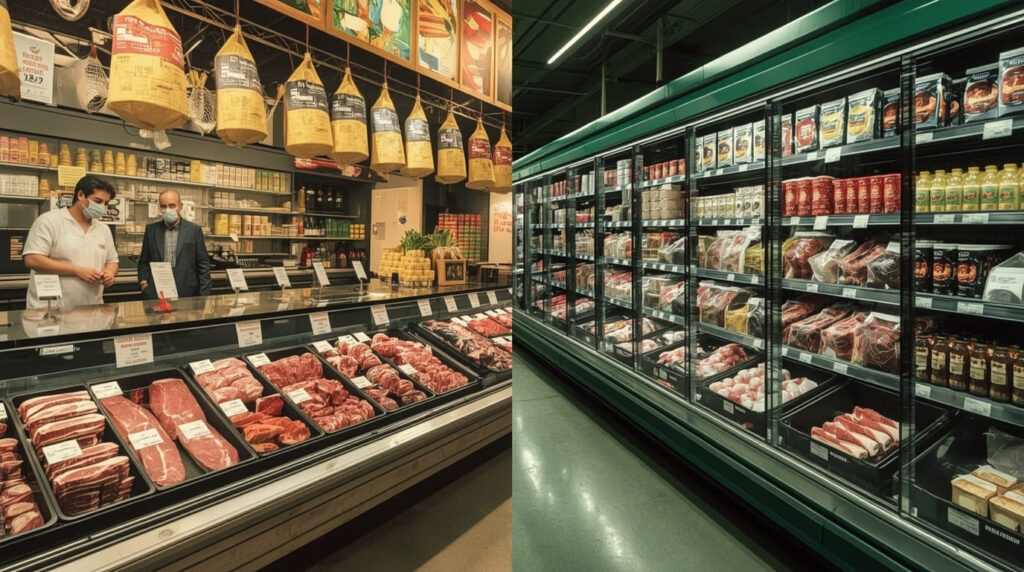Butcher vs. Packaged Meat: A Head-to-Head Freshness Showdown
For home cooks, deciding between butcher meat vs packaged options can feel like a tug-of-war between custom service and everyday convenience. Is fresher always found at the counter, or can sealed packages deliver just as well?
This is the exact challenge the Shop Smart method is made for. In this guide, I’ll walk you through the strengths and trade-offs of each, so your next meat purchase is clear—and never a guess.
Key Takeaways
- For the ultimate in freshness, expert help, and specialty cuts, the butcher counter is tough to beat.
- Pre-packaged meat wins for speed, clear pricing, and quick shopping—perfect for busy nights.
- Both options offer freshness; knowing how to spot it in each form is your true superpower.
- The "right" choice is always personal and depends on your meal, money, and schedule that day.

🛒 Fresh Meat Comparison: The Path to Your Plate
The butcher counter often starts with bigger cuts and breaks them down in-store. This means your steak or chops are sliced or ground just hours before you buy them—especially true for ground beef, which is usually made fresh daily. The meat also moves quickly from counter to customer.
The downside? Once sliced and exposed to air, the clock ticks on freshness. If not wrapped well at home, these cuts won’t last as long—so plan to cook them soon.
Pre-Packaged Meat
Pre-packaged meat is usually processed and sealed at a central plant, often using vacuum-seal or gas flush methods to slow spoilage. This process keeps air out, letting meat stay fresh for days or even weeks on a store shelf.
The trade-off, however, is time: these packages may have traveled farther and been processed days before you see them. The freshness is preserved by technology more than timing.
At the butcher counter, you get direct access to an expert. Want a two-inch-thick steak or just the right amount of fat trimmed? The butcher can do it, and often gives great advice for cooking or swapping cuts. Many also work with trusted local farms or offer dry-aged specialties you can’t easily find in the case.
However, quality depends on the butcher’s skill and sources. Some shops deliver top-tier meat every time, while others might vary. It’s always smart to ask about the meat’s origin if you care about sourcing.
Pre-packaged meat levels the playing field with clear grades like USDA Prime, Choice, or Select right on the label. So, whether you’re buying in one store or another, you know what to expect—every package of “Choice” ribeye should deliver similar juiciness, every ground beef pack lists its fat percentage.
But you can’t ask for special trims or thicker cuts. What you see really is what you get. For weeknight meals, that’s great. For celebrations, you might miss the butcher’s touch.
The Convenience Factor: A Conversation vs. Grab-and-Go
The Butcher Counter
A good butcher is like having a meat coach: you can ask about cooking, portions, or find something special for a recipe. This personal touch is a huge help, especially if you’re new to certain cuts or cooking methods.
On the flip side, it takes more time. You may need to wait in line, have a conversation, and sometimes plan your shopping trip around the butcher’s hours.
Pre-Packaged Meat
Nothing beats the speed of picking up what you need and heading to checkout. See it, grab it, done. You can shop at your pace and even check nutrition and price labels as long as you want.
The trade-off: if you have a question, there’s no one to answer. And if that perfect roast isn’t in the case? You’re out of luck unless you want to head to the counter.
At a Glance: Butcher vs. Packaged Meat
Factor
Freshness
Quality
Cost
Convenience
The Butcher Counter
Cut fresh daily, shorter shelf life
Custom cuts, expert advice
Higher per pound, less waste
Slower, requires interaction
Pre-Packaged Meat
Longer shelf life, longer supply chain
Consistent USDA grades
Lower per pound, sales common
Extremely fast, grab-and-go
The Verdict: What's the Best Place to Buy Meat for YOU?
So, what does this really mean for your Tuesday night burgers versus Saturday’s special dinner? It all comes down to your needs right now.
Choose the Butcher Counter If...
- You want a custom cut, special trim, or expert cooking tips for a unique meal.
- You care about peak, just-cut freshness and are ready to cook soon.
- You value knowing how your meat was sourced, or want to try dry-aged or specialty cuts.
Choose the Pre-Packaged Meat If...
- Speed is your top priority.
- You want to stick to a budget, take advantage of sales, or stock up for the week.
- You only need standard cuts for regular meals—with no surprises on price or portion.
Your Smart Shopping Strategy for Meat
The truth is, there’s no one-size-fits-all answer in the butcher meat vs packaged debate. The best shoppers know when to choose each option: sometimes it’s about speed and simplicity, other times it’s about that perfect steak or expert advice.
Frequently Asked Questions
Is butcher meat always better quality?
Not always. A high-grade packaged steak (like USDA Prime) can be better than a low-grade butcher steak. The best clue is the grade and source—both options can deliver excellent meat.
Where is a good place to buy steak specifically?
How can I find the best place to buy meat near me?
Look up online reviews for local butchers and check supermarket reputations. Don’t be afraid to try several places and compare their quality for yourself.
Are online meat delivery services a good option?
Ready to Keep More Food Fresh?
- Get our 1-page printable checklist
- Join the “Stay Fresh” email list
- See the full Triple-S Method series
